|
|
|
|
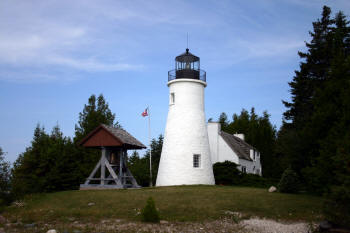
OLD PRESQUE ISLE LIGHT
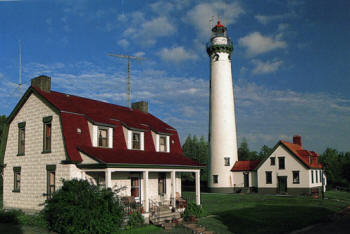
NEW PRESQUE ISLE LIGHT
40 MILE POINT LIGHTHOUSE
|
Did You Know? 01
Produced by the Presque Isle County
Historical Museum
The “Castles” of Presque
Isle County
No, there aren’t really any castles in Presque Isle
County . . .but we do have three lighthouses that have
tall towers, very similar to the towers on castles in
Europe.
Most
of the lighthouses were built in the 1800’s to guide
ships operating on the Great Lakes. The bright lights
shone from their towers warned ships of shallow water.
With the invention of radar and sophisticated navigation
systems, however, ships no longer have to rely on the
lighthouses. Most of them have been decommissioned, and
many have been turned over to groups that operate them
as tourist attractions.
There are 122
lighthouses in Michigan, and Presque Isle County is
fortunate to have three of them. They are Forty Mile
Point Lighthouse, Old Presque Isle Lighthouse, and New
Presque Isle Lighthouse.
The Old Presque
Isle Lighthouse was built in 1840, and is the oldest
manmade structure in Presque Isle County. It is located
on Lake Huron, about halfway between Rogers City and
Alpena. Its four-foot-thick stone tower has hand-carved
steps and a chain banister to guide you to the top.
The New Presque
Isle Lighthouse was built in 1870, farther out on the
point than the old lighthouse. Its brick tower rises
113 feet from its limestone foundation, making it the
tallest lighthouse on Lake Huron. To get to the top,
you have to climb 130 steps. You can see the tower’s
light from twenty-one miles out on Lake Huron.
The Forty Mile
Point Lighthouse, built in 1896, is northwest of Rogers
City on Lake Huron. Aptly named, it is located 40 miles
southeast of Old Mackinaw Point Light and 40 miles
northwest of Thunder Bay Island Light. The lighthouse
has a brick duplex residence attached to its
52-foot-high tower. The lighthouse keeper and his
family lived on one side, while the assistant keeper and
his family occupied the other side.
During the summer
season, all three of the lighthouses in Presque Isle
County are open to the public. |
|
|
===================================================
BLUE
HIGHWAYS
Did You Know? 02
This photo shows the passenger and freight steamboat
Marine City at a dock in Rogers City. It was the
first steamboat to regularly call at Rogers City, and it
brought many of the earliest settlers to the area. The
Marine City was propelled by “sidewheel” paddle
wheels. You can clearly see the decorative covering
over the sidewheel. The big wooden arch strengthened
the hull, and kept it from bending too much. Most
passengers stayed in cabins on the upper deck. The
lower deck was used mainly to carry freight. The boat’s
wheelhouse at the bow was in the “birdcage,” or Gothic
style.
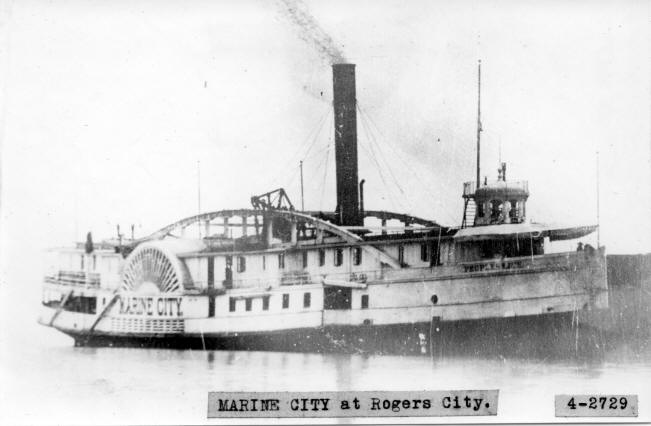
Early settlers traveled to and from Presque Isle County
mainly on the “blue highways.” The “blue highways” were the
lakes and rivers that make up the Great Lakes’ system. They
were the same “highways” the Indians had used for hundreds of
years.
In 1870, when the first settlers arrived at Rogers City,
there were about 2,500 ships operating on the Great Lakes.
About 1,900 were sailboats, mainly schooners, while the other
600 were steam-powered. The number of sailboats had peaked in
the1860s, and their numbers were shrinking each year. At the
same time, the use of steam-powered boats was increasing each
year.
Sailboats depended on the wind. If there wasn’t any wind,
the sailboats couldn’t make any progress. The steamboats could
operate whether there was wind or not, so they were much more
reliable.
Most settlers traveled on passenger and freight steamers like
the Marine City. The wood-hulled Marine City had
been built in Marine City, Michigan, in 1866. It was 192 feet
long and 28 feet wide. It had two decks of cabins for
passengers, and all sorts of freight could be carried on the
lower decks. On a typical trip up the lakes, the Marine City
might have carried several cows, crates of chickens, bales
of hay, bags of corn, crates of merchandise, kegs of salt and
gunpowder, and all sorts of lumbering tools and farm
implements. Virtually everything needed to sustain life in the
north woods came on the boats.
The Marine City traveled between Cleveland, Detroit,
and Mackinac Island, with stops at many communities located
along Lake Huron’s shore. Like many of the early steamboats, it
was propelled by paddlewheels located in the middle of the
ship.
The sailboats carried mainly freight, lumber, and bulk
cargoes, like stone, coal, iron ore, and grains. Many were also
used as barges, towed along behind steamers or steam-powered
tugs. It was common for a steamer to tow four or five such
barges.
Most of the lumber shipped out of Presque Isle County was
loaded aboard wood-hulled boats called “steam barges,” or
“lumber hookers.” Lumber was loaded in their cargo holds, and
stacked high on their decks. One of the steam barges, the C.
H. Starke, operated out of Rogers City for many years.
When the Michigan Limestone plant at Rogers City began
shipping limestone in 1912, most of it was carried in giant,
steel-hulled lake freighters like the Calcite. The
420-foot-long Calcite was built for Michigan Limestone.
It was the first boat in the company’s fleet of self-unloading
limestone carriers.
While most of the passenger and freight business around the
Great Lakes was eventually taken over by railroads, trucks,
automobiles, and airplanes, giant steel freighters still carry
limestone from Rogers City to ports around the Great Lakes.
Some of today’s freighters are more than 1,000 feet long —
longer than three football fields laid end-to-end! They steam
up and down the lakes on the same “blue highways” used for
hundreds of years by Indians in birch-bark canoes. |
===================================================
BLUE
HIGHWAYS
Did You Know? 03
|
Rogers City’s
Bradley Boats
In 1910, the Michigan Limestone and Chemical
Company was established. The company began
building a limestone quarry and processing plant
at the village of Crawford’s Quarry, just south
of Rogers City. At the same time, the company
contracted with the Detroit Shipbuilding Company
to build a large steel freighter. The freighter
would be used to haul stone from the plant at
Rogers City to ports around the Great Lakes.
Production of limestone began at the
company’s Calcite Plant in the summer of 1912.
The second ship to load at the plant was the
company’s brand new Steamer Calcite. The
Calcite was the first of seven
“self-unloading” ships that would eventually be
built for the Bradley Transportation fleet,
which was owned by Michigan Limestone. In the
1950s and 1960s, four ships from U.S. Steel’s
Pittsburgh Steamship fleet were also transferred
to the Bradley fleet. Before they began hauling
limestone from the plant at Rogers City, the
four were converted to self-unloaders.
These self-unloading ships were unique. A
self-unloader has a conveyor system that carries
limestone from the cargo hold to an “unloading
boom” on the deck. A conveyor belt on the long,
steel boom then carries the cargo to the end of
the boom. This boom can be raised and turned so
it extends over the side of the ship, where the
cargo falls into a pile on the dock. With this
system, a self-unloading ship can unload just
about anywhere. Ships that aren’t self-unloaders
can only go to ports that have equipment, such
as big cranes, that can dig cargo out of a
ship’s cargo hold. Many small ports around the
lakes don’t have that kind of equipment. So if
they want a load of stone or coal, it has to be
delivered by a self-unloading ship.
When the Steamer Calcite and other
early Bradley boats were built, there were very
few self-unloading ships. Today, however,
almost all the ships on the Great Lakes are
self-unloaders.
Most of the sailors who worked on the Bradley
boats were from Rogers City or other communities
in Presque Isle County. Some of these sailors
were lost at sea. Two of the Bradley ships were
victims of shipwrecks. The Steamer Carl D.
Bradley sank during a Lake Michigan storm in
the fall of 1958. Thirty-three crew members
died in the sinking. In 1965, the Steamer
Cedarville sank in the Straits of Mackinac
after it collided with another ship. Ten
Cedarville crewmen were lost as a result of
the accident.
Of the ships built for the Bradley fleet,
only the John G. Munson is still in service.
Three of the converted ships are still in
operation, but are owned by other companies.
------------------------------------------------------------------------------------------------------------------------------------------------------
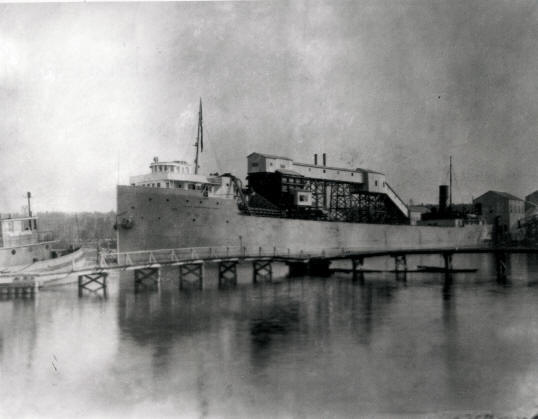
Photo Above - The brand new steamer
Calcite loading for the first time at the
Michigan Limestone dock at Rogers City on
Wednesday, June 26, 1912. Many Rogers City
residents were on hand to watch the giant ship
load. In order to demonstrate how a
self-unloading vessel could unload its cargo,
the Calcite’s boom was swung out over the
water and part of her cargo was discharged. The
Calcite was retired during the 1961
season, after 48 years of service with the
Bradley Transportation fleet. During that time,
she had carried 4,605 cargoes. When the ship
was cut up for scrap, her pilothouse was removed
and returned to Rogers City.
It can be seen today on the grounds of the Forty
MilePoint Lighthouse, north of Rogers City. |
===================================================
THE
SINKING OF THE CARL D. BRADLEY
Did You Know? 04
|
Sinking of the
Carl D. Bradley
One of the
most tragic events in Rogers City’s history was
the sinking of the Steamer Carl D. Bradley.
The Bradley was a limestone freighter
whose home port was Rogers City. On November
18, 1958, the Bradley got caught in a
severe storm on northern Lake Michigan, with
twenty-five to thirty-foot waves, and wind gusts
around seventy-five miles an hour.
At 5:30 p.m. a loud “thud” was heard aboard
the ship. First Mate Elmer Fleming, in the
ship’s pilothouse, spun around and noticed the
stern of the ship sagging badly. It was
instantly obvious to Fleming that the Bradley
was breaking in half.
As mountainous waves and high winds tore at
the ship, Fleming grabbed the radio microphone
and broadcast a “Mayday” message to the Coast
Guard and ships in the area: “Mayday!” Fleming
yelled. “This is the Carl D. Bradley.
Our position is twelve miles southwest of
Gull Island. The ship is breaking up in heavy
seas. We’re going to sink. We’re going down!”
The Bradley sank quickly. Fleming and
three other crewmen made it to a life raft, but
only Fleming and Frank Mays, a deck watchman,
survived. With search and rescue efforts
hampered by the savage storm, the two clung to
the raft for more than fourteen hours before
being rescued by the Coast Guard Cutter
Sundew.
Thirty-three men perished in the sinking.
The bodies of eighteen Bradley crewmen
were pulled from the frigid waters of Lake
Michigan. Fifteen other crewmen were never
found. Most of the men on the Bradley
were from Rogers City, or other communities in
Presque Isle County. Over fifty children were
left fatherless in the aftermath of the sinking.
No one knows exactly what caused the ship to
sink, although many theories exist. Today the
wrecked hull of the Bradley lies 360 feet
deep in Lake Michigan.
------------------------------------------------------------------------------------------------------------------------------------------------
Below - A painting of the Steamer
Carl D. Bradley battling a storm on Lake
Michigan on November 18, 1958. The painting by
Ken Friedrich, a former Bradley crewmember,
depicts the boat breaking in half. Only 2 of
the ship’s 35 crewmembers survived the sinking.
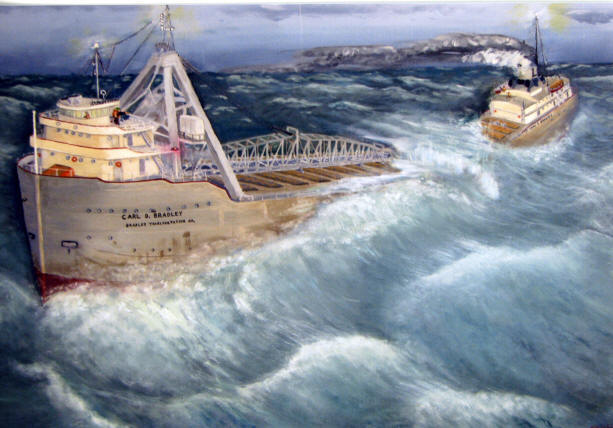 |
===================================================
CCC Camps in Presque Isle
County
Did You Know? 05
|
Millions of
Americans were without work when Franklin Delano
Roosevelt took office in 1933, during the Great
Depression. To make work for unemployed young
men, Roosevelt started the “Emergency
Conservation Work Program,” better known today
as the Civilian Conservation Corps.
To be
eligible for the program a person had to be a
veteran, or a young man between the ages of 18
and 25 whose family was on welfare. The men had
to sign up for enrollments of 6 months to 24
months. The first “CCC Camps,” as they were
called, opened in the spring of 1933, and by
July 275,000 men had joined. Between 1933 and
when the program ended in 1942, almost three
million men participated.
The men lived in camps that were set up by
the Army. They lived in tents, and ate meals in
mess halls, just like soldiers did. The CCC men
mainly worked on conservation projects for the
Department of Agriculture and Department of the
Interior. Enrollees were paid $30 a month, and
each man was expected to send at least $15 to
his family.
The initial
quota for Presque Isle County was 22 men, but
more than 100 applications were received. Very
few of the men met the qualifications for the
program.*
Two camps
were set up in Presque Isle County in 1933.
Both camps were made up of men who had served in
the Spanish-American War or World War I. Camp
Hawks was located at Lake May, south of Hawks.
Camp Black Lake was located at Ocqueoc Lake.
Men at both camps were involved in building
roads and bridges, planting trees on thousands
of acres of barren land, planting
hatchery-raised fish in lakes in rivers,
fighting forest fires, installing telephone
lines, erecting fire towers, and constructing
buildings, water systems, fences, trails,
benches, and tables at Onaway and Hoeft state
parks. Some men from the Black Lake camp also
helped build a runway at the Onaway airport.
By the early
1940s, the country’s economy had improved
significantly, and it became difficult to enroll
men in the program and many camps were shut
down. The CCC program itself ended shortly
after the United States entered World War II in
December of 1941.
While more
than sixty years have passed since the CCC camps
ended, the Black Lake Camp is still in
existence. It is now owned by Presque Isle
County and operates as the Ocqueoc Outdoor
Center. It is one of the few surviving CCC
camps in the nation.
* The first
men from Presque Isle County to join the CCC
were: Watson Labiak, Earl Lowe, Shirley
Hartwick, Ernest Wright, George Duncan, Albert
Dunbar, Loren Dinsmore, Jr., Angus Morgan,
Eldred McLean, Norman King, Jack McClary, Clyde
Davis, Donald Frazier, Vern Smith, Chester
McQuaid, Vern Dickerson, Edwin Ducap, Melvin
Lozen, Edmund Ferko, Adolph Filipiak, Edward
Smith, Glen Storrs, Max Kaminski, Reuben
Bruning, and Albert Stricker. Some of the men
may be the grandfathers, or great-grandfathers,
of your students.
Information
provided by Gerald Micketti.
---------------------------------------------------------------------------------------------------------------------------------------------
Photo Below -
One of the buildings at the CCC camp at Black
Lake. Today, the camp is known as the Ocqueoc
Outdoor Center. Many of the buildings built at
the camp in the 1930s are still in use.
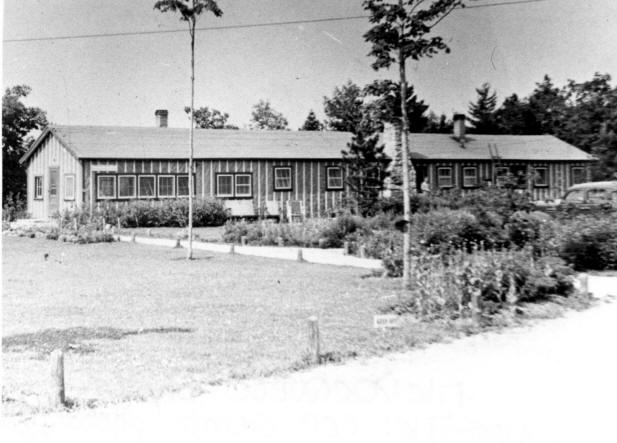 |
===================================================
Crawford’s Quarry—The
County Seat
Did You Know? 06
|
Before the first settlers arrived at what
would become Rogers City, there was a settlement
called Crawford’s Quarry, located where the
Calcite Plant is today. In 1864, Francis
Crawford purchased property along the shore and
moved his wife and three sons to the area. He
planned to cut wood to supply steamboats
traveling up and down Lake Huron.
On his property, Crawford found a large hill
of limestone that he thought could be used as
building stone. He cut and polished some of it,
but when he sent samples to buyers, they found
it was too porous and soft for building
purposes. Despite that, the little community
that grew up around Crawford’s dock came to be
known as Crawford’s Quarry.
When the settlement of the village of Rogers
started around 1870, an intense rivalry quickly
developed between Rogers and Crawford’s Quarry.
The village of Rogers built a courthouse on land
donated by William E. Rogers, namesake of the
little community. Crawford’s Quarry, like
Rogers, wanted to be the county seat, and there
was much quarreling between the two communities.
In 1874, Leonard Crawford was elected
supervisor, and the county offices were moved
from Rogers to Crawford’s Quarry. Residents of
Crawford’s Quarry authorized $1,000 to build a
courthouse there. It was an octagon-shaped
building heated by a wood stove that was
purchased for $50. On November 5 1874, the
County Board of Commissioners met in the new
courthouse at Crawford’s Quarry and voted to get
rid of the courthouse in Rogers. Residents of
Rogers refused to allow their courthouse to be
demolished.
In an 1875 election, the village of Rogers
was established as the county seat. Following
that election, the courthouse at Crawford’s
Quarry was permanently closed, and the stove was
moved to the courthouse in Rogers City.
Rogers continued to grow, while Crawford’s
Quarry, once a community of 225 people and
numerous businesses, saw its population
dwindle. In 1910, the newly-formed Michigan
Limestone and Chemical Company purchased all the
property around Crawford’s Quarry. Crawford’s
Quarry was finally going to become a limestone
quarry. Some residents stayed on at Crawford’s
Quarry into the 1920s, but they were eventually
forced out by the expansion of Michigan
Limestone’s Calcite Plant. Today, there are few
signs that the community ever existed.
Most of this information is from Nina
Ferdelman’s Virgin Forests to Modern Homes,
published in 1947. |
===================================================
Presque Isle County Assassin
Did You Know? 07
|
The Presque Isle
County Man Who Assassinated President McKinley
He
stood in line with other visitors to the
Pan-American Exposition in Buffalo, New York, in
order to shake hands with the President of the
United States. But, when his turn came, instead
of shaking hands he squeezed the trigger of his
.32 caliber pistol and fired two bullets into
President William McKinley. He was immediately
knocked down and beaten by soldiers, police, and
angry citizens. In fact, the man was almost
killed on the spot.
The man was Leon
Czolgosz, pronounced “Chōl-gŭsh.” Prior to
September 6, 1901, nobody had ever heard of Leon
Czolgosz; after that date he became infamous.
President McKinley died on September 13, 1901,
and Czolgosz was eventually tried and found
guilty of his murder.
This
incident of American history is mentioned not
only because Czolgosz was the assassin of
President William McKinley, but because Czolgosz
had once lived in Presque Isle County. In fact,
at the time of the assassination, members of his
family were still living in the area.
Leon
Czolgosz was born in Detroit in 1873, a few
months after his parents emigrated from the
Prussian province of Posen, Poland. Seven years
later the family moved north, living six months
in Rogers City and five years in Posen. The
family then moved to Alpena. After five years
in Alpena, the family moved to Natrona,
Pennsylvania, near Pittsburgh, and lived there
for two years before moving to Cleveland. An
uncle, Joseph Czolgosz, lived on a farm six
miles north of Posen, and was known as an
industrious and prosperous farmer. Another
uncle, John Czolgosz, lived in Posen, and Leon’s
brother Frank lived in Metz Township.
Czolgosz’s trial was probably the shortest on
record, at least as far as presidential
assassins go. His trial commenced September 23,
1901, and Czolgosz was found guilty after only
two days. He was executed in the electric chair
on October 29th. Afterwards his clothes and
effects were burned. As Czolgosz was being
buried, sulfuric acid was poured into his coffin
to hasten disintegration of the body.
Information taken
from the Presque Isle County Advance,
September 12, 1901, and the Detroit
News-Tribune, September 8, 1901.

|
===================================================
Their Family Doctor Was An
Indian
Did You Know? 08
American Indians who lived
in the Great Lakes region would have been very familiar with the area
now known as Presque Isle County.
In all likelihood, Indians traveled along the Lake Huron shore
for thousands of years before the first white settlers came to the
region. While they often
stopped to fish, hunt, or gather berries, few Indians settled here
permanently.
One who did was an Indian named John Shavinaw.
He lived along the Lake Huron shore in the area now called Bell
Pines, near Bell Bay and False Presque Isle.
George Kauffman, born near Presque Isle in 1891, said that John
Shavinaw was a “medicine man,” or Indian doctor.
When one of the Kauffman children was ill, their father often
asked John Shavinaw to treat them.
After examining the child, the medicine man would go into the
woods to get herbs, bark, and roots to make medicine.
The medicines he made always seemed to cure the children’s
ailments. Mrs. Kauffman
said he saved her children’s lives more than once.
John Shavinaw never charged the Kauffman’s for his services, but
he was always willing to take some food home with him.
According to the Kauffman’s, John Shavinaw lived to be 109 years
old. They say he is buried
in a cemetery in the woods at Bell.

Taken
from George H. Kauffman, My
Recollections of Early Grand Lake,
privately published in 1973.
Photo
08 Kauffman Homestead -- The
log home that John Kauffman built for his family in 1862, the year the
American Civil War began.
The cabin is still around today, located near Grand Lake.
===================================================
Early Settlers – Part 1
Did You Know?
09
While Indians,
trappers, lumbermen, and fishermen had all
visited Presque Isle County,
the first permanent settler
was Frederick Burnham, a native of Ohio.
His father had been given property at Presque Isle Harbor, along
the Lake Huron shore in the southeastern part of the county, for his
service in the War of 1812.
Burnham arrived there in 1840, the same year the first Presque Isle
Lighthouse was completed.
Burnham cut timber and built a dock so he could sell firewood to passing
steamers. The steamboats
burned the wood as fuel.
The area where he built his home and dock was known as Burnham’s
Landing. It was the first
permanent settlement in Presque Isle County.
Another early settler at Presque Isle was John Kauffman, who had
come to the United States from Germany.
In 1854, Kauffman was on his way to find work in Chicago, when
the sailboat he was on was wrecked near Presque Isle in a bad storm.
He swam ashore and went to work cutting wood for Frederick
Burnham. In 1862, Kauffman
built a home from squared timbers near Grand Lake.
That building is still standing today, making it the oldest home
in Presque Isle County.
The village of
Crawford’s Quarry was founded by Francis Crawford, who came to the area
around 1860 to invest in timber and timberland.
Crawford’s Quarry was located where the Calcite Plant is today,
just south of Rogers City.
Like Burnham’s Landing, Crawford’s Quarry was originally a place where
wood-burning ships could buy fuel.
Later it became an important shipping point for forest products.
“The Quarry,” as it was commonly called, was the entry point for
many of the early settlers, and it soon developed into a small
community. At one
time it had a hotel, general store, flour mill, school, brewery, Western
Union telegraph office, and post office.
In 1868, William
Rogers, Frederick Denny Larke, Albert Molitor, and John Raymond arrived
to survey the area that is now Rogers City.
They were the first settlers of the village of Rogers, which
eventually became Rogers City.
The village was named for William Rogers, who was in charge of
the surveying party.
Rogers and
Molitor purchased the land where Rogers City is now located, planning to
lumber in the area, which was covered with pine forests.
Early in the spring of 1869, Frederick Denny Larke piloted a
large party of German and Polish immigrants north.
Larke worked with the new settlers to locate the town, cutting
down the first tree upon the spot selected for the site of Rogers City.
They cut holes in the ice in order to get soundings, so a dock
could be built for ships to land.
Robert Horn, one of the first settlers, said that when he arrived
in 1870, the village was mostly a forest with clearings here and there
-- just large enough for a tent or log house.
There were no streets at that time.
When Rogers first
came into being, it occupied the first two blocks on First Street,
between Huron Avenue and Erie Avenue.
At the end of Huron Avenue, the Molitor dock extended
into the lake. The Kitchen House, which burned and was later
rebuilt, was the first hotel.
Beck Funeral Home now occupies the second Kitchen House building.
A row of houses on both sides of the street occupied just over
two blocks. That’s all
there was to Rogers City!
The early German
and Polish settlers came to the Rogers City area because there were jobs
in the lumber industry, but they also knew there was free land available
through federal and state “homestead” programs.
For a fee of less than $5, they could get 40 to 160 acres of land
from the government. All
they had to do was pay the fee and agree to build a home and cultivate
the land. The homestead
program had great appeal to these people, many of whom had been farmers
in their home countries. In
fact, many had left their homes in Germany or Poland because it was
impossible for them to own land there.
“Lumber and land”—that’s what brought the early settlers to the
wilderness of northern Michigan.
Most of this
information is from Nina Ferdelman’s
Virgin Forests to Modern Homes,
originally published in 1947.
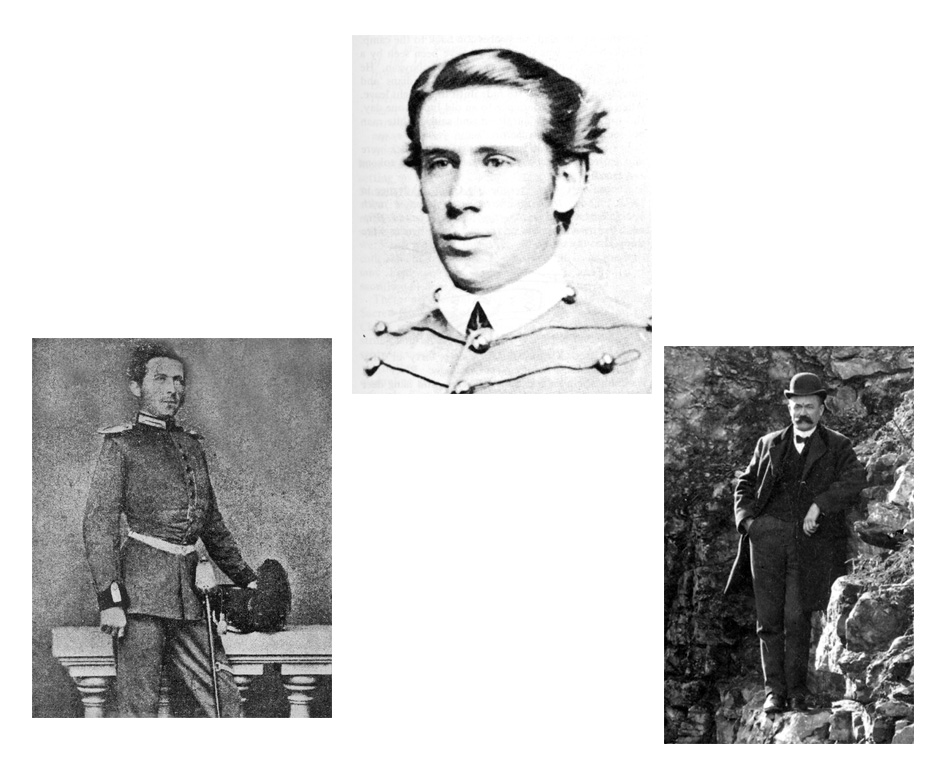
Photo
Top: William
Rogers.
Left: Albert
Molitor.
Right:
Frederick Denny Larke
===================================================
Early Settlers – Part 2
Did You Know? 10
Unless you are one
hundred percent Native American on both sides of your family, you have
one or more ancestors who came to this country from someplace else.
People who came here from other countries are called
“immigrants.”
When the early
settlers came to Presque Isle County, the area was a frontier
wilderness. One of the
earliest settlers was a carpenter named Friedrich Horn.
He and his family had emigrated from Germany in 1865.
They were living in Detroit in 1870, when Albert Molitor, who had
started a lumbering operation in the area that is now Rogers City,
recruited Friedrich. When
Horn arrived in Rogers, there were no houses, except for the one
occupied by Molitor. All of
the other settlers lived in tents.
Horn was told to “pick a lot, build a house, then go and get your
family.”
When Horn’s family
arrived several months later, they found an “endless forest,” with only
a small opening here and there in the woods with a log cabin, tent, or
temporary shack built of rough pine boards.
There were no streets, no churches, no school, and only one
little store that was operated by Molitor’s lumber company.
In one direction there were woods and more woods.
In the other direction, there was nothing but sky and water.
It was a hard and lonely existence for those early settlers, and
it would remain a hard and lonely existence for many years.
Why then, would
people like Friedrich Horn willingly move to the northern Michigan
wilderness? In fact, why
would Friedrich Horn and his family have left their ancestral home in
Germany?
The answer to the
first question is easy:
There were no jobs for carpenters in Detroit in 1870, especially for a
man like Friedrich Horn who was then 55 years old.
At the same time, carpenters and lumberjacks were badly needed in
Presque Isle County.
We don’t know
exactly why Friedrich Horn uprooted his family and moved to the United
States in 1865. However,
hundreds of thousands of German and Polish people left their historic
homelands and came to North America around that time, and we know the
major factors that influenced them.
The largest numbers
of immigrants from northern Europe were looking for improved standards
of living. In other words,
they wanted better lives than they had in their home countries.
Many came looking for work, others came because free land was
available here, and some came to escape famines or the many wars that
ravaged their homelands.
Some immigrants came here specifically to avoid compulsory military
service in their home countries.
Then, too, there were always immigrants who were seeking
religious freedom, or trying to avoid being persecuted for their
religious beliefs. Finally,
a few were undoubtedly criminals, fleeing to North America to avoid
imprisonment, or worse.
Despite the many
hardships experienced by the early settlers, immigrants like Friedrich
Horn and his family were persistent.
Horn lived in Rogers until his death in 1894.
He is remembered today for having organized the first religious
services in the village, and he built the village’s first church and
many of the earliest homes.
Today, more than 135 years after Horn arrived in the wilderness of
northern Michigan, many of his descendants still live in the Rogers City
area.
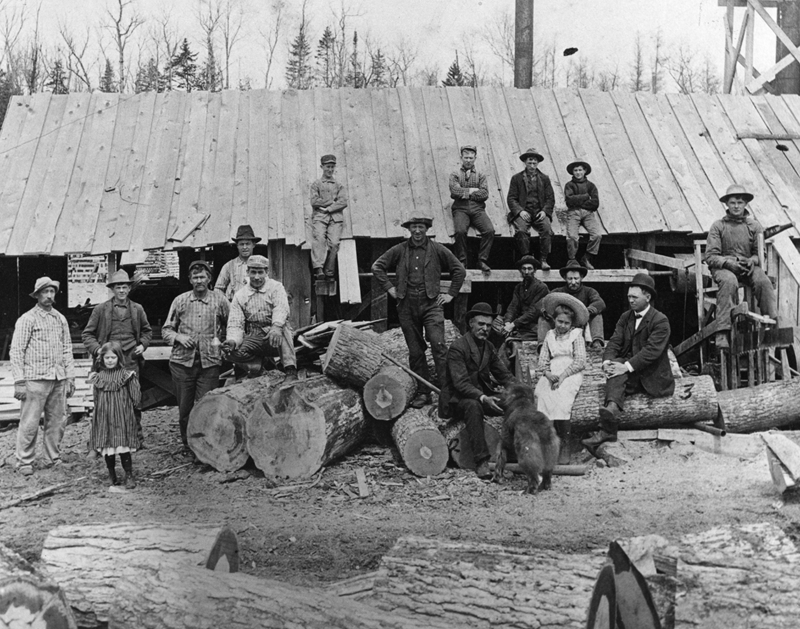
Photo
10 Early Settlers – Presque Isle County was built by the
lumber industry. Most of
the early settlers came here because their were jobs in the lumber
industry, or in related businesses.
Here employees at a sawmill pose for a photographer.
Most of the adults came here as immigrants, mainly from Germany
and Poland.
===================================================
Rogers City’s Famine Winter
Did You Know? 11
Rogers City’s first winter was called
the "famine winter.” In the
fall of 1870, the Rogers and Molitor Lumber Company had stored an
enormous amount of flour, pork, beans, split peas, syrup, and other
supplies for the winter. A
lot of additional supplies were scheduled to be brought in on the
steamer Marine City’s last trip of the shipping season.
Unfortunately, an early cold spell swept over the northern lakes,
and with ice forming in the rivers and bays, the Marine City was
laid up for the winter.
The failure of Rogers and Molitor to receive their last shipment
of the season created a very serious situation, since they operated the
only store in the small community.
As the long northern winter dragged on, the village ran short of
provisions. Coffee and sugar were entirely gone, while flour and
pork, as well as other necessities, had to be rationed in small
portions.
Help was not available because Rogers
City was almost 40 miles from the nearest settlement, and there were no
roads on which to travel. Snowfall was heavy that winter, with storms
frequently dropping three to four feet on the area..
By late April, the food supply in
Rogers was nearly exhausted.
Fortunately, spring finally arrived.
Thawing weather and south winds caused the ice to become brittle,
driving it far out into the lake. The
Marine City was finally able
to steam north, loaded with provisions.
She tried to make a landing through the ice at Crawford's Quarry,
but the ice was too thick, so the ship steamed up to Rogers City.
There was too much ice there, too, and the Marine City could not
make it to the dock. Since
the weather was warm and the lake was calm, the ship inched up to the
very edge of the ice field.
A mail pouch and a number of light boxes of coffee, tea, and other
needed supplies were slid onto the ice, where men from the community
could retrieve them. The
captain of the Marine City promised to come back as soon as the
ice was gone. And that he
did, finally bringing an end to what soon came to be referred to as “the
famine winter.”
Most of this information was taken
from Nina Ferdelman’s Virgin
Forests to Modern Homes and the Horn family history on file at the
Presque Isle County Historical Museum.

Photo
11
Famine Winter –
Passengers stretch their legs on the ice, Atlantic stuck in the ice.
|